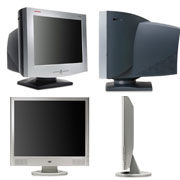
However, LCD monitors have thin flat screen. Therefore occupies very less space and is lighter than the CRT monitor. LCD monitors can be fixed even on wall. Display Size: Even though the display size of a CRT monitor is calculated diagonally, the actual display size is smaller. For instance a 17" CRT monitor will actually have a display size of only 16" However, the display size of 17" LCD monitor will have 17" display size. Resolution: CRT monitors can show different resolutions. The resolution can be changed as required. LCD Monitors will have Native Resolution and therefore has a fixed resolution. The best resolution will be the native resolution for that LCD monitor. Viewing Direction: A CRT screen can be viewed from all directions. And from different distance. But LCD monitors cannot be viewed from all directions. LCD monitors can only be viewed straight. Therefore its viewing direction is limited. If viewed from other directions the colors will change and sometimes the vision will be unclear if not viewed straight. But in recent years the new LCD monitors have improved on this defect. Radiation Emission: The radiation emission in CRT monitors are higher. This will not be visible normally but it will affect eyesight and may cause head ache. Long term use of these monitors may even affect the eyes adversely. LCD monitors do not have this type of Radiation emission. Therefore LCD monitors are good for the eyes. Price: CRT monitors are priced very cheap. However they consume more power. LCD monitors are priced higher, but they consume less electricity. Though the electricity consumption is not very significant for personal use, it is very cost efficient in big organizations with many computers.

LCD Monitor
Text and images (scans of census records) are crisper and sharper and the LCD monitor is easier on your eyes. Dot pitch: This is the space between dots and is measured in fractions of a millimeter, e.g., .25mm. The smaller the number the better because the dots are tighter. Many manufacturers don%u2019t even list the dot pitch anymore and you probably won%u2019t be able to tell the difference between a .22 and .27 pitch anyway. So, if you like the monitor then don%u2019t worry about the dot pitch. Passive-matrix vs. active-matrix: Do not buy a passive-matrix monitor. I seriously doubt you%u2019ll even see one for sale, but%u2026just in case. Having said that, there are some new passive-matrix technologies that are worth buying. If the monitor isn't TFT (a type of active-matrix), look for CSTN or DSTN (the latest passive technologies). Brightness: How bright is the picture, expressed as cd/m (I have no idea what the units mean). Look for a brightness level of 200 cd/m or greater. Again, if the monitor specs don%u2019t list this value (not all do) be sure you can get your money back. If the lighting in your office (kitchen table) is subdued the brightness factor won%u2019t be as important as if you have a lot of sunlight streaming in. Don%u2019t pay extra for extra brightness unless you%u2019re worried about bright sunlight. Overall, the contrast ratio will have a bigger impact on picture quality. Monitor's size: Traditional monitors are similar to a TV because both of them have the CRT (Cathode Ray Tube). That is the reason for its bigger size. It therefore occupies more space at the desk. It is also heavy. However, LCD monitors have thin flat screen. Therefore occupies very less space and is lighter than the CRT monitor. LCD monitors can be fixed even on wall. Display Size: Even though the display size of a CRT monitor is calculated diagonally, the actual display size is smaller. For instance a 17" CRT monitor will actually have a display size of only 16" However, the display size of 17" LCD monitor will have 17" display size. Resolution: CRT monitors can show different resolutions. The resolution can be changed as required. LCD Monitors will have Native Resolution and therefore has a fixed resolution. The best resolution will be the native resolution for that LCD monitor.

CRT
Speaking of easy on your eyes, there isn't any glare, and the flat screen means no distortion. By the way, even those expensive old-fashioned flat screen CRT monitors have some distortion. Monitor's size: Traditional monitors are similar to a TV because both of them have the CRT (Cathode Ray Tube). That is the reason for its bigger size. It therefore occupies more space at the desk. It is also heavy. However, LCD monitors have thin flat screen. Therefore occupies very less space and is lighter than the CRT monitor. LCD monitors can be fixed even on wall. Display Size: Even though the display size of a CRT monitor is calculated diagonally, the actual display size is smaller. For instance a 17" CRT monitor will actually have a display size of only 16" However, the display size of 17" LCD monitor will have 17" display size. Resolution: CRT monitors can show different resolutions. The resolution can be changed as required. LCD Monitors will have Native Resolution and therefore has a fixed resolution. The best resolution will be the native resolution for that LCD monitor. Viewing Direction: A CRT screen can be viewed from all directions. And from different distance. But LCD monitors cannot be viewed from all directions. LCD monitors can only be viewed straight. Therefore its viewing direction is limited. If viewed from other directions the colors will change and sometimes the vision will be
Credit: Carl Deveraux
No comments:
Post a Comment